Ferry Electrification Energy Demand and Particle Swarm Optimization Charging Scheduling Model Parameters Analysis
Abstract
:1. Introduction
- −
- Direct charging from the shore network (AC or DC);
- −
- Combined charging using own diesel generators (DG) and shore network;
- −
- Combined charging using a shore energy storage system (ESS) and power supply from the shore.
2. Literature Review
Comparison with Other Recent Research
3. Materials and Methods
3.1. Split City Port Features
3.2. Split City Port Study Case—Ferry Fleet Energy Demand Analysis
3.3. Optimization Methods and Methodology
- −
- Change of navigational schedule,
- −
- The introduction of additional vessels on certain lines;
- −
- Installation of diesel generators;
- −
- Application of a battery ESS on the shore;
- −
- Construction of electric energy charging stations on island piers;
- −
- Charging optimization.
- (1)
- Creating initial solution particles using a greedy algorithm;
- (2)
- Creating reference initial solution particle used as a control dataset;
- (3)
- Creating random initial solution particles used for testing different scenarios;
- (4)
- The above particles are combined to create the initial population.
- (1)
- The charging schedule should be generated according to the sailing schedule and daily energy needs, considering constraints;
- (2)
- Discrete coding of input sailing schedule table into charge schedule;
- (3)
- Decoding of the repaired charging schedule due to overnight charging;
- (4)
- Combining created particles into the initial population;
- (5)
- Calculating new max power and preparing data for the Gantt chart;
- (6)
- Processing data for chart display;
- (7)
- Combining results of previous steps into single particle structure.
- (1)
- The difference in the particle’s current position vector is calculated concerning the local and global minima;
- (2)
- The velocity vector and the new location of the particle are calculated;
- (3)
- The particle is moved to a new location based on the obtained values;
- (4)
- The particle’s movement affects the charge schedule, so the coded schedule is repaired, and then a new schedule is created;
- (5)
- The maximum power is calculated based on the new schedule. Data is prepared and processed to create Gantt charts;
- (6)
- In each new iteration, the particle is updated;
- (7)
- The next particle is processed;
- (8)
- When all initially defined particles have been processed, the algorithm stops.
4. Results and Discussion
4.1. Population Size Analysis
4.2. Inertia Weight Factors Analysis
5. Conclusions
Author Contributions
Funding
Institutional Review Board Statement
Informed Consent Statement
Data Availability Statement
Conflicts of Interest
References
- European Commission, Atlas Maps Main Sources of Air Pollution for 150 European Cities. Available online: https://joint-research-centre.ec.europa.eu/jrc-news-and-updates/atlas-maps-main-sources-air-pollution-150-european-cities-2021-11-17_en#:~:text=In%202019%2C%20they%20were%20estimated%20to%20have%20caused,pollution%20vary%20greatly%20from%20one%20city%20to%20another (accessed on 10 May 2024).
- European Environment Agency, Croatia–Air Pollution Country Fact Sheet. Available online: https://www.eea.europa.eu/themes/air/country-fact-sheets/2022-country-fact-sheets/croatia-air-pollution-country (accessed on 5 June 2024).
- European Environment Agency. Available online: https://www.eea.europa.eu/publications/air-quality-in-europe-2021/health-impacts-of-air-pollution#:~:text=In%202019%2C%20air%20pollution%20continued%20to%20drive%20a,premature%20deaths%20were%20attributed%20to%20acute%20ozone%20exposure (accessed on 19 May 2024).
- IMO, Revised GHG Reduction Strategy for Global Shipping Adopted. Available online: https://www.imo.org/en/MediaCentre/PressBriefings/pages/Revised-GHG-reduction-strategy-for-global-shipping-adopted-.aspx (accessed on 25 November 2024).
- European Commission, European Green Deal: Agreement Reached on Cutting Maritime Transport Emissions by Promoting Sustainable Fuels for Shipping. Available online: https://malta.representation.ec.europa.eu/news/european-green-deal-agreement-reached-cutting-maritime-transport-emissions-promoting-sustainable-2023-03-23_en (accessed on 29 November 2024).
- European Council, Fuel EU Maritime Initiative. Available online: https://www.consilium.europa.eu/en/press/press-releases/2023/07/25/fueleu-maritime-initiative-council-adopts-new-law-to-decarbonise-the-maritime-sector/ (accessed on 25 October 2024).
- DNV Energy Transition Outlook 2024. Available online: https://www.dnv.com/publications/energy-transition-outlook-2024/ (accessed on 19 November 2024).
- World Energy Investment 2024. Available online: https://www.iea.org/data-and-statistics/data-product/world-energy-investment-2024-datafile (accessed on 21 October 2024).
- Hrvatska Elektropriveda, Izvješće o Poslovanju i Održivosti Grupe za 2023. Godinu. Available online: https://www.hep.hr/UserDocsImages//dokumenti/Izvjesce%20o%20odrzivosti//HEP_Izvjesce_poslovanje_odrzivost_2023.pdf (accessed on 24 January 2025).
- Kirkaldy, N.; Samieian, M.A.; Offer, G.J.; Marinescu, M.; Patel, Y. Lithium-ion battery degradation: Measuring rapid loss of active silicon in silicon–graphite composite electrodes. ACS Appl. Energy Mater. 2022, 5, 13367–13376. [Google Scholar] [CrossRef] [PubMed]
- Elkafas, A.G.; Shouman, M.R. A Study of the Performance of Ship Diesel-Electric Propulsion Systems From an Environmental, Energy Efficiency, and Economic Perspective. Mar. Technol. Soc. J. 2022, 56, 52–58. [Google Scholar] [CrossRef]
- Harris, T.; Kennedy, A. Low Friction Recoating Performance Improvements Aboard A Passenger Ferry. In Proceedings of the SNAME Maritime Convention, Providence, RI, USA, 27–29 October 2021. Paper Number: SNAME-SMC-2021-056. [Google Scholar] [CrossRef]
- Adland, R.; Cariou, P.; Jia, H.; Wolff, F.-C. The energy efficiency effects of periodic ship hull cleaning. J. Clean. Prod. 2018, 178, 1–13. [Google Scholar] [CrossRef]
- Tadros, M.; Ventura, M.; Guedes Soares, C. Design of Propeller Series Optimizing Fuel Consumption and Propeller Efficiency. J. Mar. Sci. Eng. 2021, 9, 1226. [Google Scholar] [CrossRef]
- Lashgari, M.; Akbari, A.A.; Nasersarraf, S. A new model for simultaneously optimizing ship route, sailing speed, and fuel consumption in a shipping problem under different price scenarios. Appl. Ocean. Res. 2021, 113, 102725. [Google Scholar] [CrossRef]
- Wartsila Technical Journal. Available online: https://www.wartsila.com/docs/default-source/Service-catalogue-files/Engine-Services---2-stroke/slow-steaming-a-viable-long-term-option.pdf (accessed on 2 January 2024).
- Yang, N.; Xu, G.; Fei, Z.; Li, Z.; Du, L.; Guerrero, J.M.; Huang, Y.; Yan, J.; Xing, C.; Li, Z. Two-Stage Coordinated Robust Planning of Multi-Energy Ship Microgrids Considering Thermal Inertia and Ship Navigation. IEEE Trans. Smart Grid 2025, 16, 1100–1111. [Google Scholar] [CrossRef]
- Fei, Z.; Yang, H.; Du, L.; Guerrero, J.M.; Meng, K.; Li, Z. Two-stage coordinated operation of A green multi-energy ship microgrid with underwater radiated noise by distributed stochastic approach. IEEE Trans. Smart Grid 2024, 16, 1062–1074. [Google Scholar] [CrossRef]
- MV Hallaig Scoltland. Available online: https://www.cmassets.co.uk/project/mv-hallaig/ (accessed on 7 May 2024).
- MV Lochinvar Scotland. Available online: https://www.cmassets.co.uk/project/mv-lochinvar/ (accessed on 7 May 2024).
- Ampere Norway. Available online: https://www.ship-technology.com/projects/norled-zerocat-electric-powered-ferry/ (accessed on 16 May 2024).
- M/F Deutschland—Scandlines Deutschland GmbH. Available online: https://www.scandlines.com/media/wt4nq2oe/datasheet_sh_deu_2020_eng.pdf?func=proxy (accessed on 3 May 2024).
- MV Prins Richard—Hybrid Ferry. Available online: https://corvusenergy.com/projects/prins-richard/ (accessed on 7 May 2024).
- M/V Prinsesse Benedikte-Hybrid Ferry. Available online: https://www.scandlines.com/about-us/our-ferries-and-harbours/ (accessed on 7 May 2024).
- MV Catriona—Caledonian Maritime Assets Ltd. Available online: https://www.cmassets.co.uk/ferry/mv-catriona/ (accessed on 7 May 2024).
- MF Tycho Brahe—Battery-Electric Car-Ferry. Available online: https://wikizero.com/www/MF_Tycho_Brahe (accessed on 7 May 2024).
- Elektra—Hybrid-Electric Ferry. Available online: https://shift-cleanenergy.com/2017/10/22/elektra-hybrid-electric-ferry/ (accessed on 15 May 2024).
- Aurora Electric Ferry. Available online: https://shift-cleanenergy.com/2017/10/21/electric-ferry-aurora/ (accessed on 9 May 2024).
- MS Color—Hybrid Ferry. Available online: https://corvusenergy.com/projects/herjolfur-iv/ (accessed on 7 May 2024).
- Herjólfur IV–Corvus Energy. Available online: https://www.ship-technology.com/projects/color-hybrid-ferry/ (accessed on 7 May 2024).
- Ellen E-ferry Danmark. Available online: https://www.danfoss.com/en/about-danfoss/news/cf/world-s-most-powerful-fully-electric-ferry-got-her-name-and-is-getting-ready-for-danish-waters/ (accessed on 10 May 2024).
- Island Discovery Canada. Available online: https://res.cloudinary.com/damen-shipyards2/image/upload/v1640261475/catalogue/ferries/road-ferry/product-sheet-road-ferry-8117E3.pdf (accessed on 24 May 2024).
- Basto Electric Norway. Available online: https://sefine.com.tr/projects/project_detail/20 (accessed on 9 May 2024).
- Wolfe Islander IV Canada. Available online: https://www.damen.com/catalogue/ferries/roro-ferries (accessed on 10 May 2024).
- MV Amherst Islander, II. Available online: https://www.bairdmaritime.com/passenger/ro-pax/vessel-review-amherst-islander-ii-hybrid-electric-ro-pax-debuts-on-lake-ontario (accessed on 7 May 2024).
- Grotte ferry Danmark. Available online: https://www.bairdmaritime.com/work-boat-world/passenger-vessel-world/ro-pax/vessel-review-grotte-battery-powered-double-ended-ro-pax-for-denmarks-fanolinjen (accessed on 24 May 2024).
- MF Hella–Corvus Energy. Available online: https://corvusenergy.com/projects/hella/ (accessed on 20 May 2024).
- MF Dragsvik–Corvus Energy. Available online: https://corvusenergy.com/projects/dragsvik/ (accessed on 18 May 2024).
- MF Leikanger–Corvus Energy. Available online: https://corvusenergy.com/projects/leikanger/ (accessed on 5 May 2024).
- Adenuga, O.T. Particle Swarm Optimization Method for Energy Management of the Hybrid System of an Electric Vehicle Charging Station. Doctoral Dissertation, Cape Peninsula University of Technology, Cape Town, South Africa, 2024. [Google Scholar]
- Mohamad, H.; Isa, A.I.M.; Zaharuddin, M.A.H.; Naidu, K.; Salim, N.A.; Yasin, Z.M. Optimal Charging Coordination of Electric Vehicles Considering Users Charging Behavior Using Particle Swarm Optimization (PSO). In Proceedings of the 2024 IEEE 4th International Conference in Power Engineering Applications (ICPEA), Penang Island, Malaysia, 4–5 March 2024; IEEE: New York, NY, USA, 2024; pp. 13–18. [Google Scholar]
- Xiao, B.; Ma, W. Research on Distributed Microgrid Group Optimization for Ships Based on Optimized Particle Swarm Algorithm. In Proceedings of the 2024 IEEE 2nd International Conference on Sensors, Electronics and Computer Engineering (ICSECE), Jinzhou, China, 29–31 August 2024; IEEE: New York, NY, USA, 2024; pp. 1749–1757. [Google Scholar]
- Meng, K.; Zhang, J.; Xu, Z.; Zhou, A.; Wu, S.; Zhu, Q.; Pang, J. Ship Power System Network Reconfiguration Based on Swarm Exchange Particle Swarm Optimization Algorithm. Appl. Sci. 2024, 14, 9960. [Google Scholar] [CrossRef]
- Iris, Ç.; Lam, J.S.L. A review of energy efficiency in ports: Operational strategies, technologies and energy management systems. Renew. Sustain. Energy Rev. 2019, 112, 170–182. [Google Scholar] [CrossRef]
- Iris, Ç.; Lam, J.S.L. Optimal energy management and operations planning in seaports with smart grid while harnessing renewable energy under uncertainty. Omega 2021, 103, 102445. [Google Scholar] [CrossRef]
- Tourist Board of Split Official Website. Available online: https://visitsplit.com/hr/6608/2024-godina (accessed on 28 January 2025).
- Grad Split. Available online: https://split.hr/kategorije/o-splitu/o-gradu (accessed on 28 January 2024).
- Port of Split. Available online: https://portsplit.hr/en/port-of-split/ (accessed on 2 January 2024).
- Split Port Authority. Available online: https://portsplit.hr/luka-split/lucka-podrucja/bazen-gradska-luka/ (accessed on 8 January 2024).
- Petković, M.; Vujović, I.; Lušić, Z.; Šoda, J. Image Dataset for Neural Network Performance Estimation with Application to Maritime Ports. J. Mar. Sci. Eng. 2023, 11, 578. [Google Scholar] [CrossRef]
- Jadrolinija. Tender Documentation, Popis Brodova Jadrolinija Gorivo Natječaj Splitsko Plovno Područje; Available on Request; Jadrolinija: Rijeka, Croatia, 2023. [Google Scholar]
- Bacalja, B.; Krčum, M.; Slišković, M. A Line Ship Emissions while Manoeuvring and Hotelling—A Case Study of Port Split. J. Mar. Sci. Eng. 2020, 8, 953. [Google Scholar] [CrossRef]
- Jadrolinija Shipping Transport Company—Sailing Schedules. Available online: https://www.jadrolinija.hr/redovi-plovidbe-i-cijene/lokalne-linije-2022 (accessed on 15 October 2022).
- Croatian Agency for Coastal Maritime Traffic. Statistical Data for 2019–2022; Internal Communication, Available on Request; Croatian Agency for Coastal Maritime Traffic: Split, Croatia, 2022.
- Wartsila 31SG. Available online: https://www.wartsila.com/insights/article/wartsila-31sg-the-worlds-most-efficient-4-stroke-engine (accessed on 4 October 2024).
- Dikkumbura, R.; Wijewardane, A. Waste Heat Recovery from Marine Engines Using Absorption Chillers for Comfort Application: A Case Study Based on Hamilton and Saryu Ship Classes. In Proceedings of the 2024 Moratuwa Engineering Research Conference (MERCon), Moratuwa, Sri Lanka, 8–10 August 2024; IEEE: New York, NY, USA, 2024; pp. 25–30. [Google Scholar]
- EN 590 Diesel. Available online: https://www.linkedin.com/pulse/en-590-diesel-density-specifications-price-morteza-hashemi (accessed on 4 November 2024).
- National Institute of Standards and Technology. Available online: https://www.nist.gov/ (accessed on 21 November 2024).
- Vujnović, I. Uporaba Alternativnih Goriva u Brodskim Enegretskim Sustavima, University of Zagreb, Faculty of Mechanical Engineering and Naval Architecture. 2020. Available online: https://urn.nsk.hr/urn:nbn:hr:235:136824 (accessed on 12 December 2024).
- Norwegian Ship Design—The World’s Largest Electric Ferry Delivered. Available online: https://www.norwegianshipdesign.no/archive/basto-electric-has-been-delivered (accessed on 4 October 2024).
- Amoussou, I.; Tanyi, E.; Fatma, L.; Agajie, T.F.; Boulkaibet, I.; Khezami, N.; Ali, A.; Khan, B. The Optimal Design of a Hybrid Solar PV/Wind/Hydrogen/Lithium Battery for the Replacement of a Heavy Fuel Oil Thermal Power Plant. Sustainability 2023, 15, 11510. [Google Scholar] [CrossRef]
- Peša, T.; Krčum, M.; Kero, G.; Šoda, J. Electric Ferry Fleet Peak Charging Power Schedule Optimization Considering the Timetable and Daily Energy Profile. Appl. Sci. 2025, 15, 235. [Google Scholar] [CrossRef]
- Peng, J.; Li, Y.; Kang, H.; Shen, Y.; Sun, X.; Chen, Q. Impact of population topology on particle swarm optimization and its variants: An information propagation perspective. Swarm Evol. Comput. 2022, 69, 100990. [Google Scholar] [CrossRef]
- Piotrowski, A.P.; Napiorkowski, J.J.; Piotrowska, A.E. Population size in particle swarm optimization. Swarm Evol. Comput. 2020, 58, 100718. [Google Scholar] [CrossRef]
- Nickabadi, A.; Ebadzadeh, M.M.; Safabakhsh, R. A novel particle swarm optimization algorithm with adaptive inertia weight. Appl. Soft Comput. 2011, 11, 3658–3670. [Google Scholar] [CrossRef]
- Ha, M.P.; Nazari-Heris, M.; Mohammadi-Ivatloo, B.; Seyedi, H. A hybrid genetic particle swarm optimization for distributed generation allocation in power distribution networks. Energy 2020, 209, 118218. [Google Scholar]
- Premkumar, M.; Sowmya, R.; Ramakrishnan, C.; Jangir, P.; Houssein, E.H.; Deb, S.; Kumar, N.M. An efficient and reliable scheduling algorithm for unit commitment scheme in microgrid systems using enhanced mixed integer particle swarm optimizer considering uncertainties. Energy Rep. 2023, 9, 1029–1053. [Google Scholar] [CrossRef]
- Zdiri, S.; Chrouta, J.; Zaafouri, A. Inertia weight strategies in Multiswarm Particle swarm Optimization. In Proceedings of the 2020 4th International Conference on Advanced Systems and Emergent Technologies (IC_ASET), Hammamet, Tunisia, 15–18 December 2020; IEEE: New York, NY, USA, 2020; pp. 266–271. [Google Scholar]
- Bao, L.; Yinsheng, S.; Xin, Z.; Ligang, Z.; Hongyue, Z.; Hefeng, Z. Research on Optimization Methods for Power System Slice Sensitivity Calculation and Presentation. In Proceedings of the 2024 International Conference on Artificial Intelligence, Deep Learning and Neural Networks (AIDLNN), Guangzhou, China, 20–22 September 2024; IEEE: New York, NY, USA, 2024; pp. 88–92. [Google Scholar]
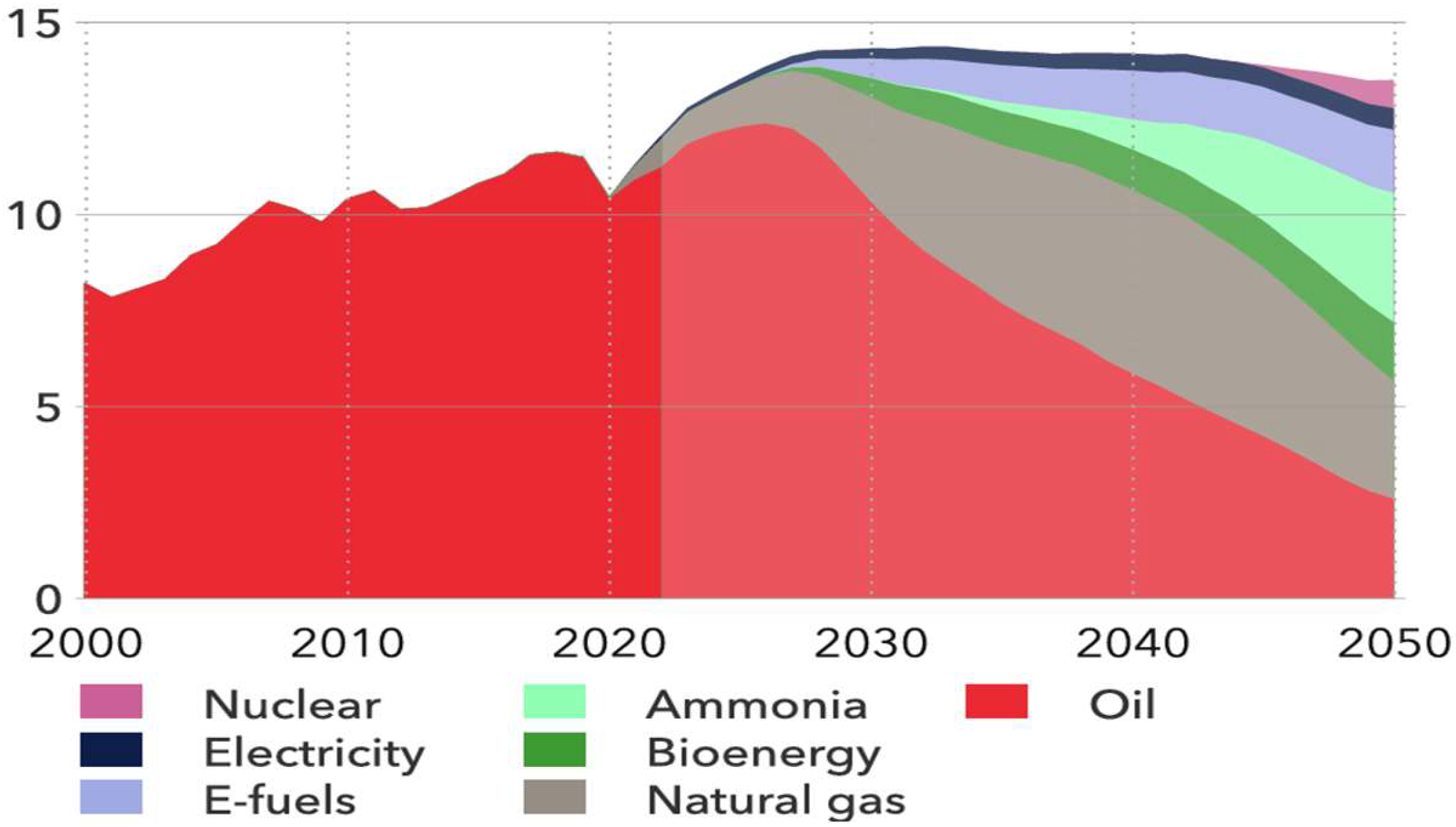
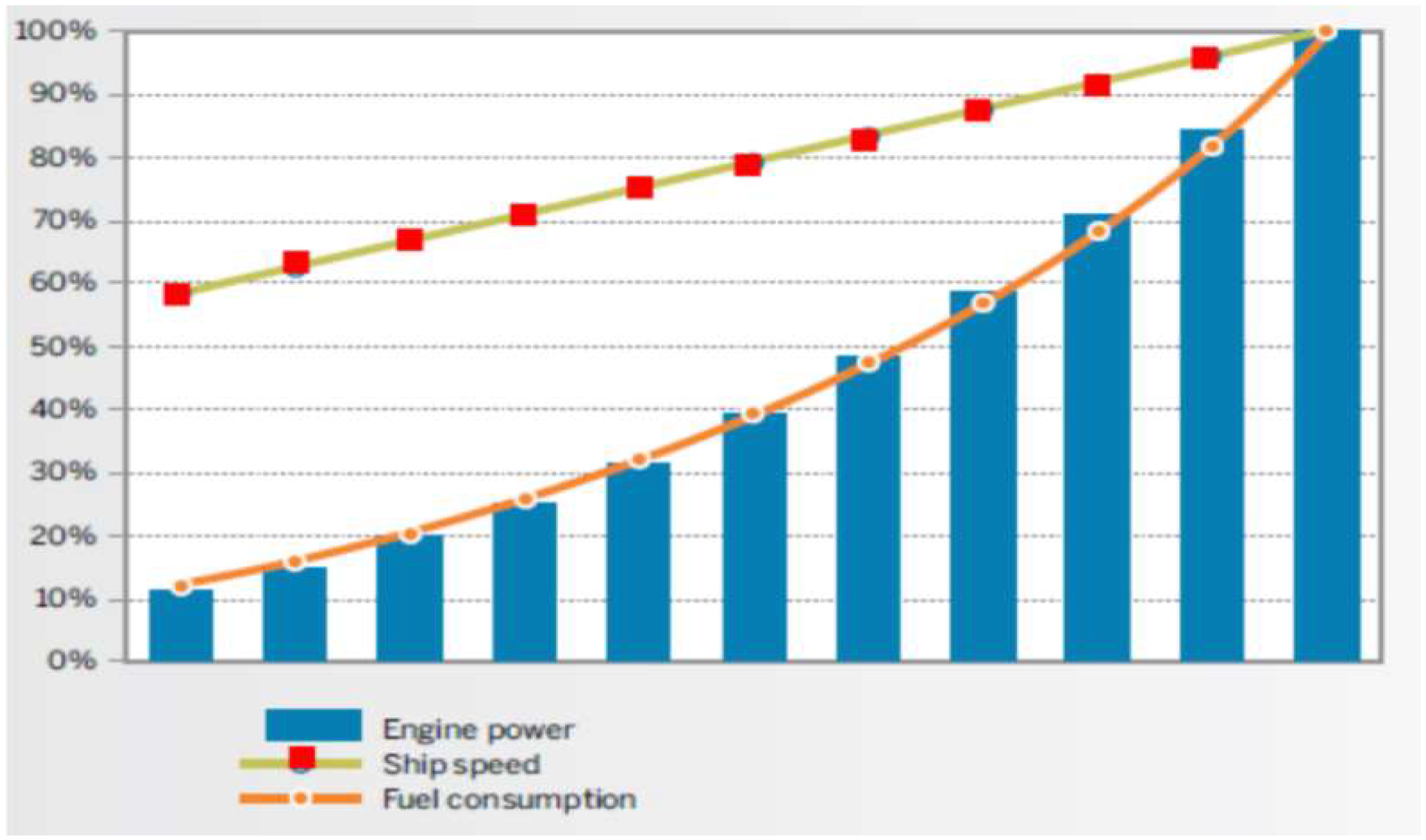

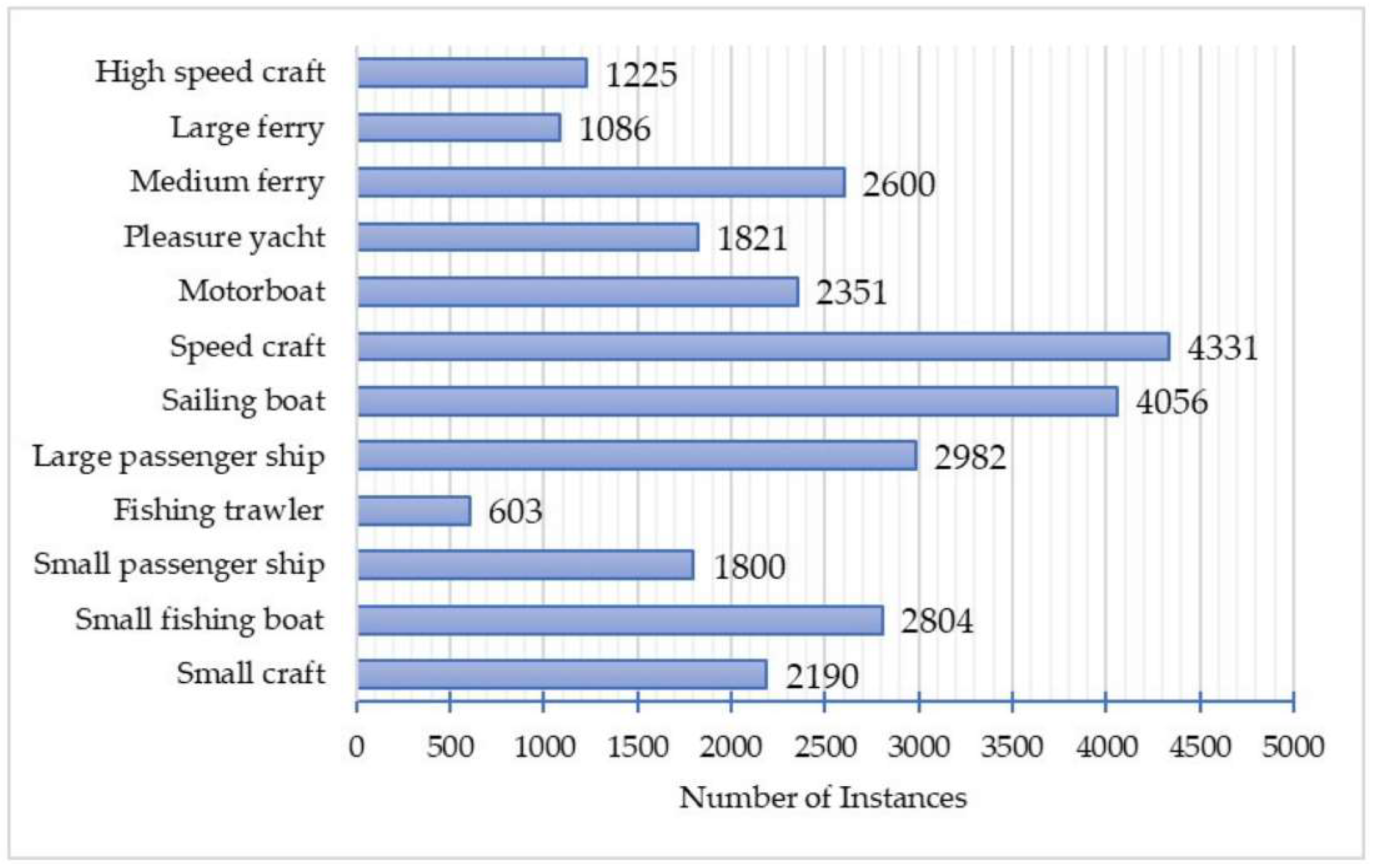
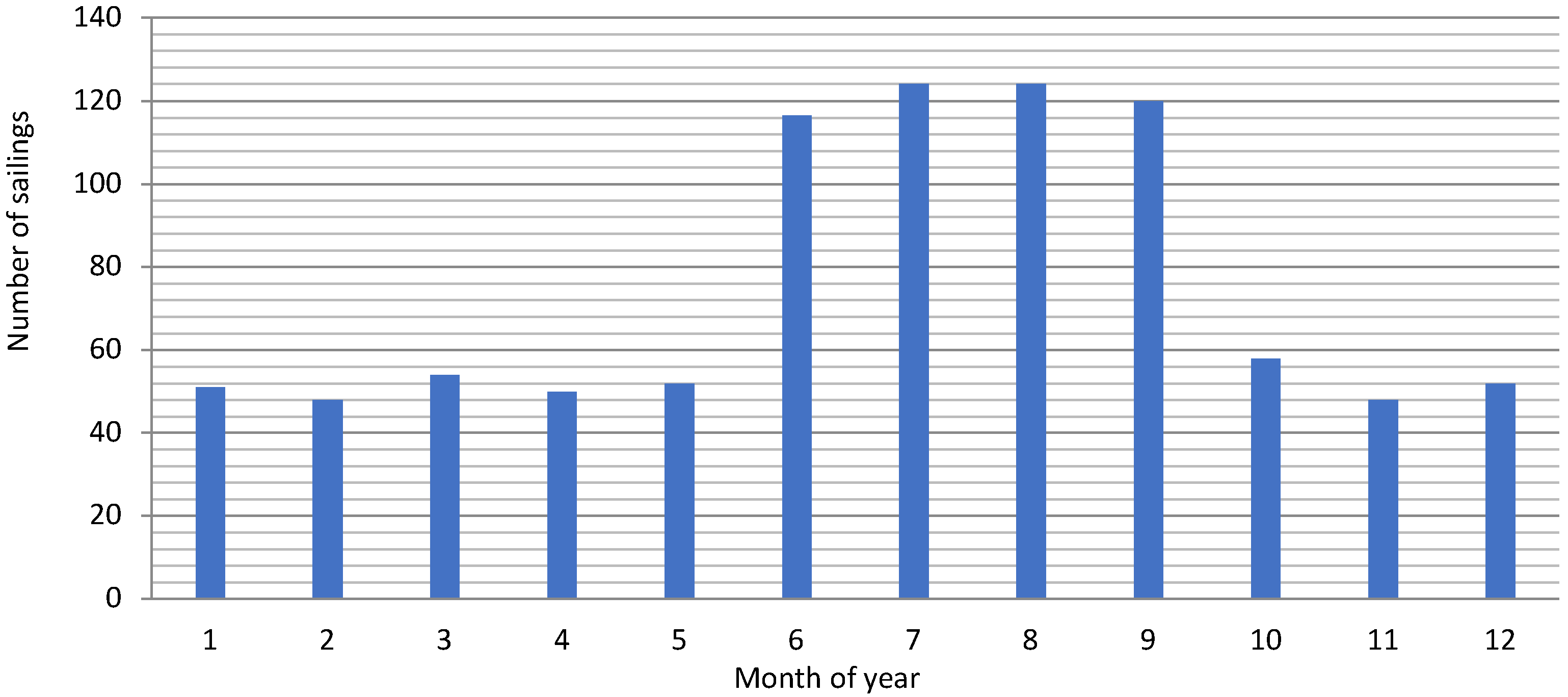
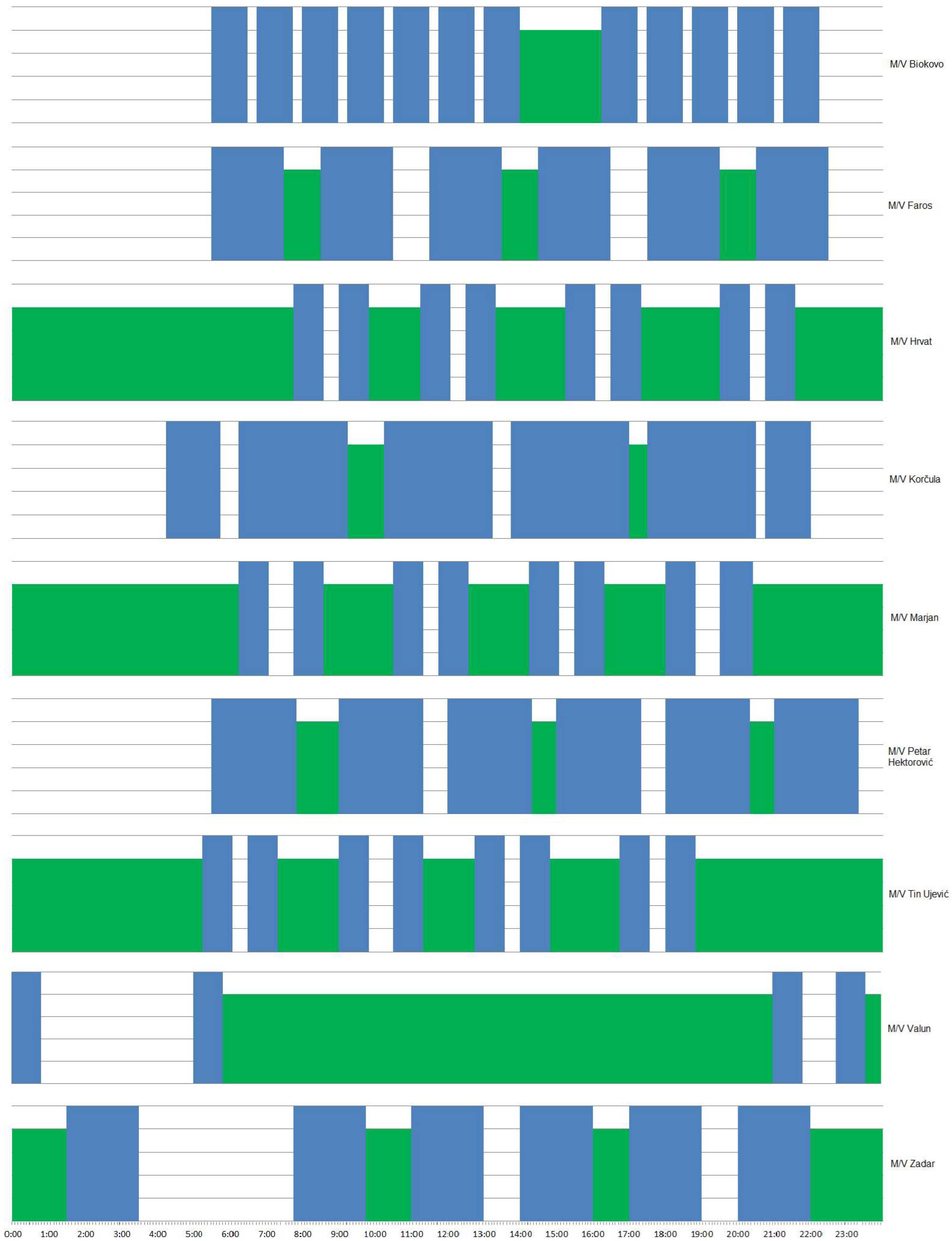
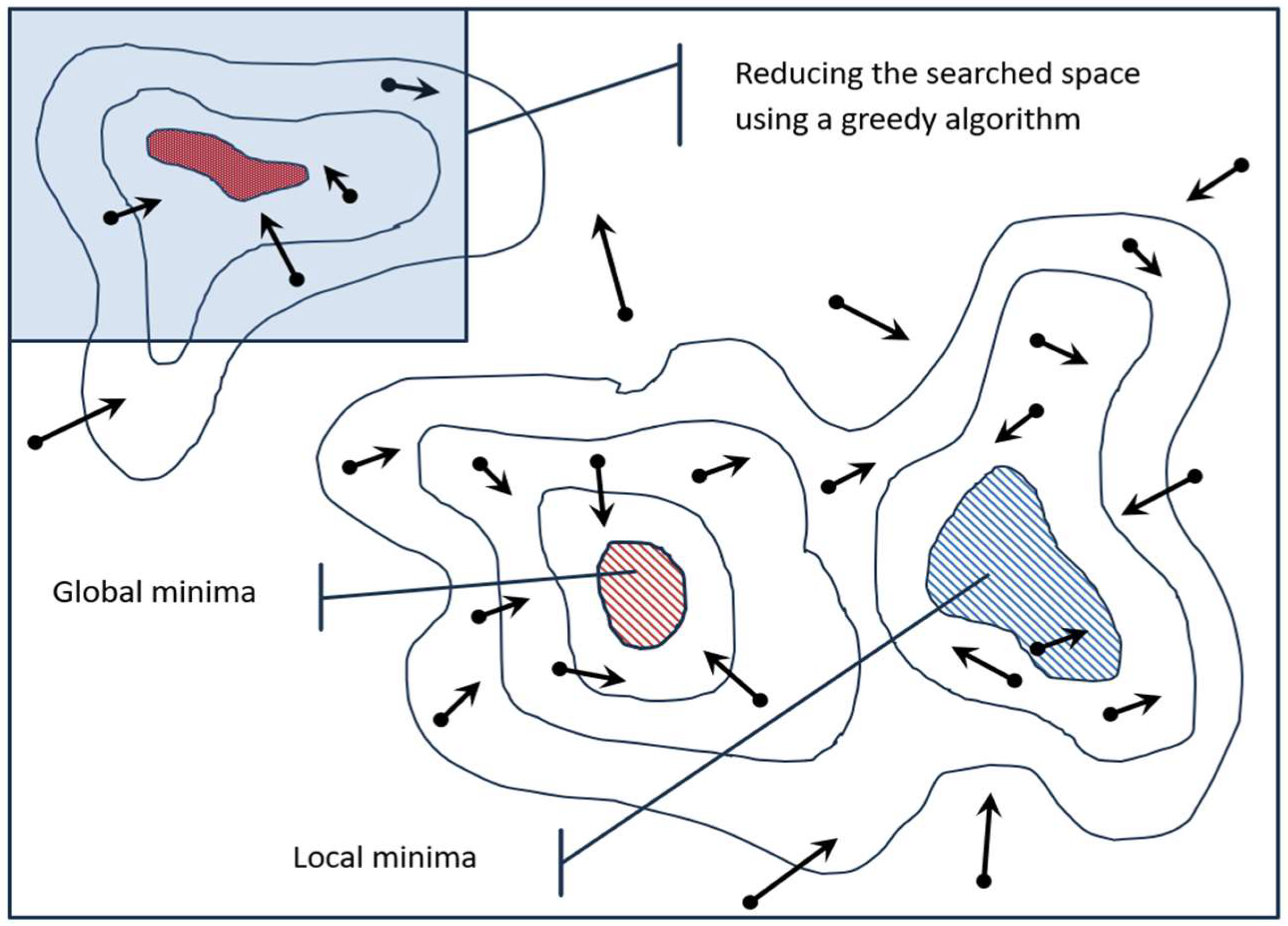

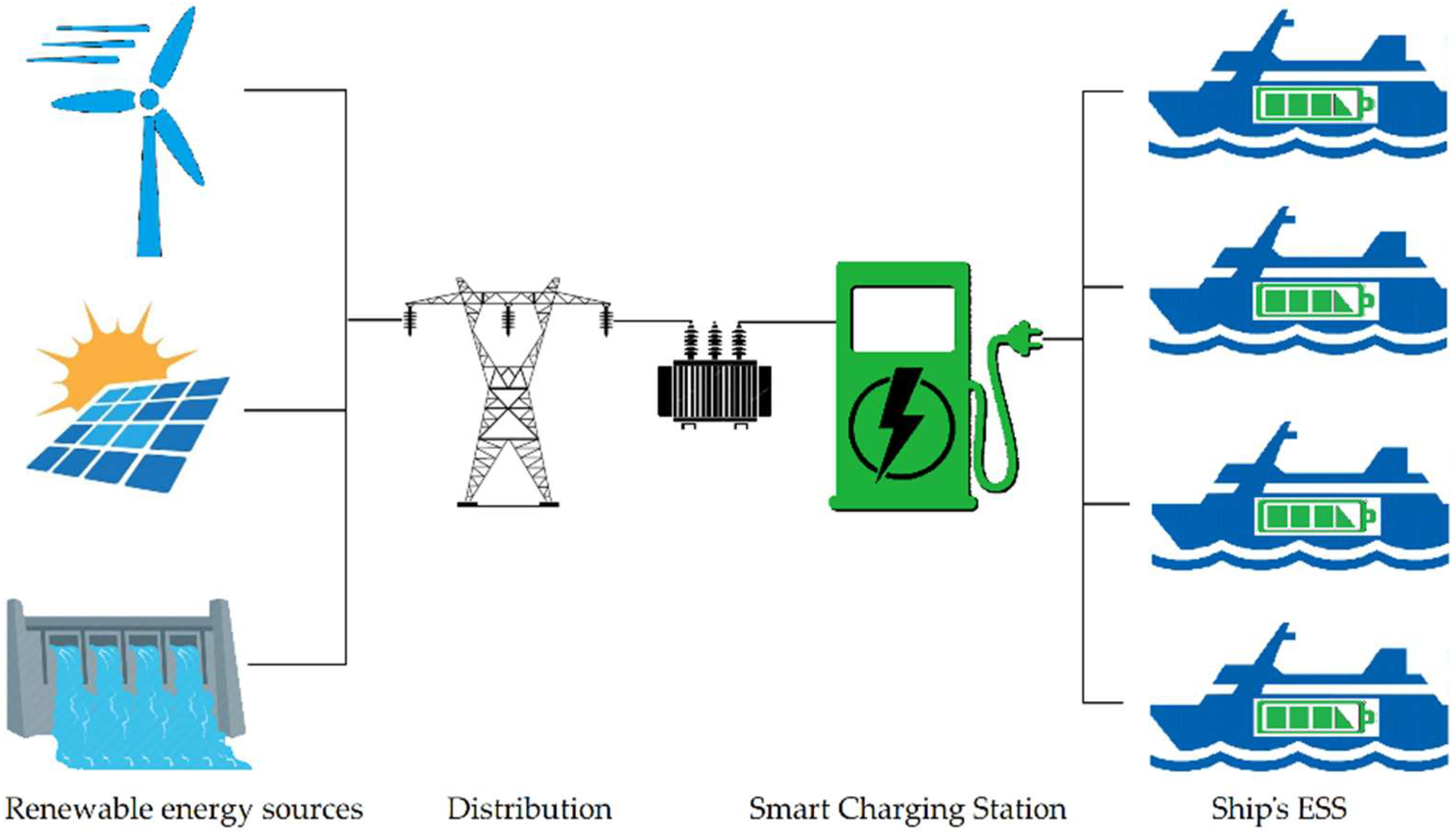
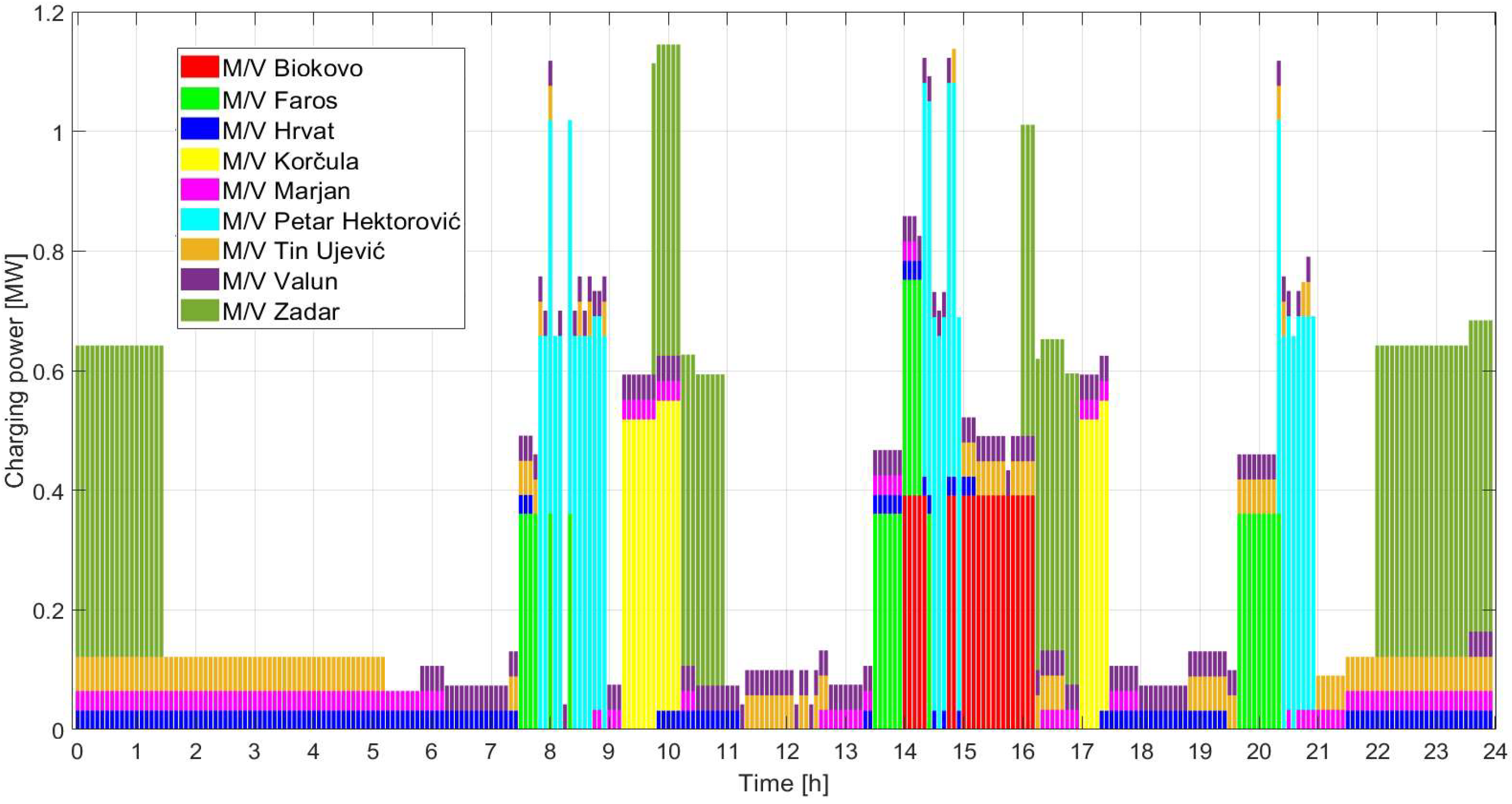

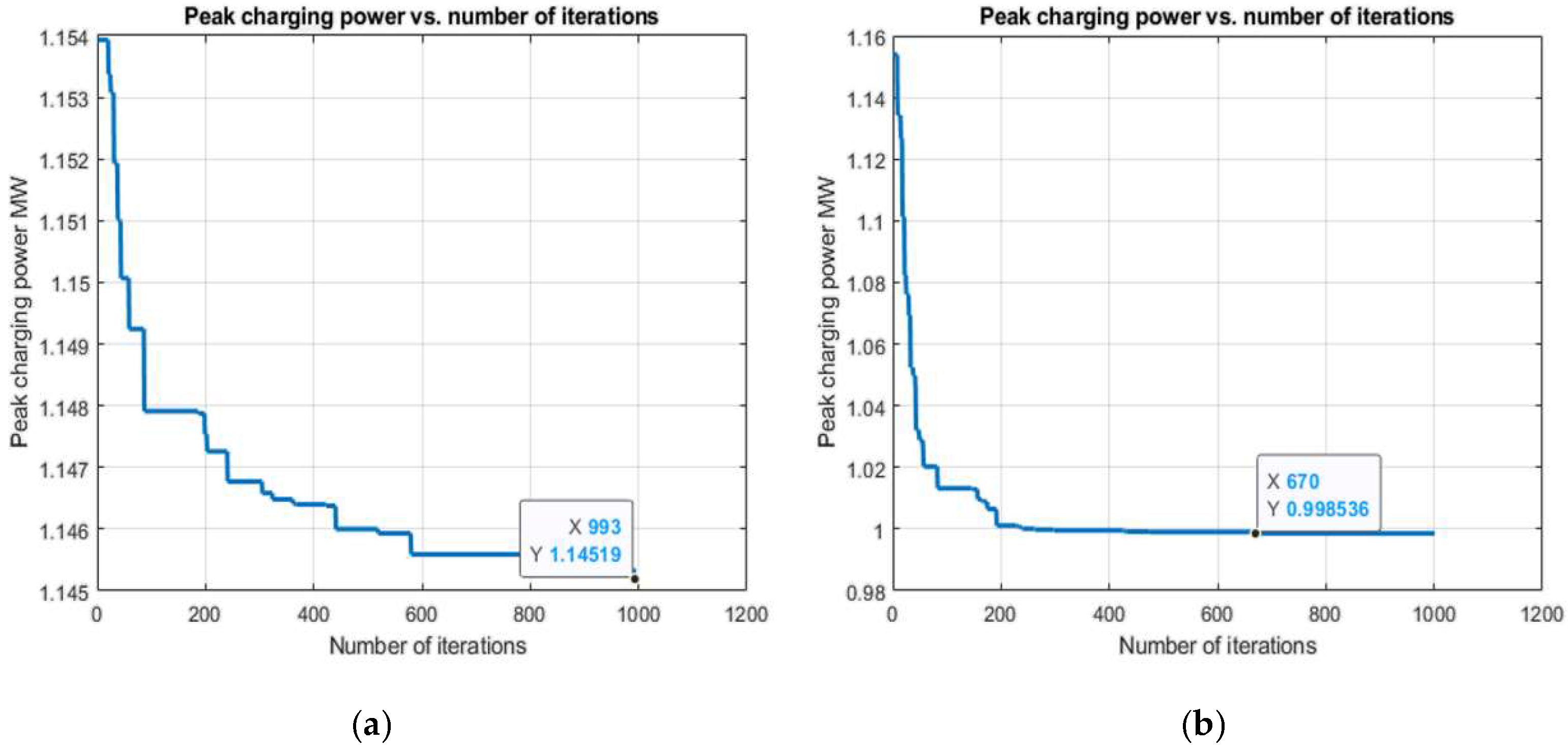


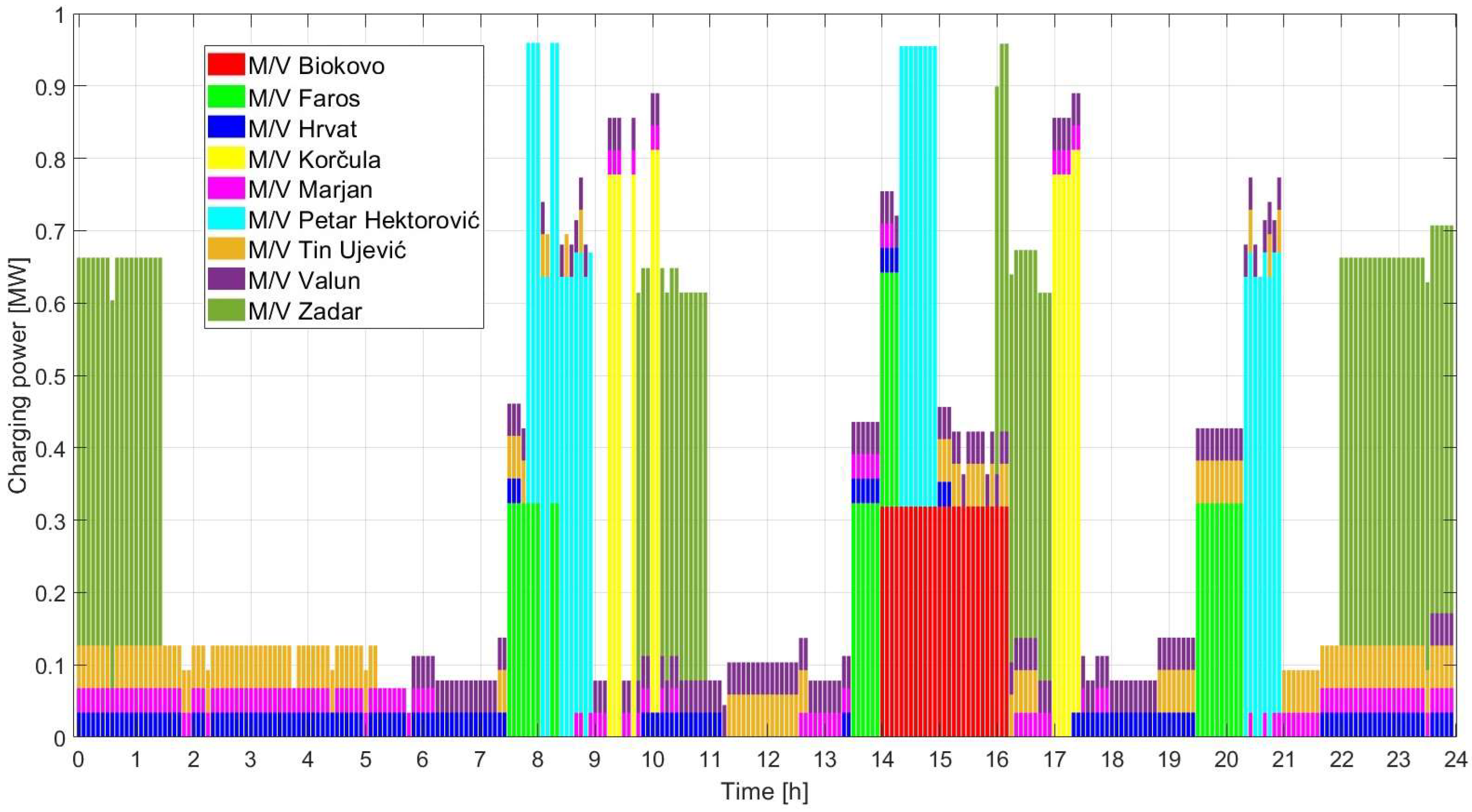
| Ref. No. | Ship Name | Year | Length Overall (m) | Passengers No. | Vehicle No. | Speed (kt) | Power (kW) | Battery Capacity (kWh) |
|---|---|---|---|---|---|---|---|---|
| [19] | MV Hallaig Scotland | 2012 | 43 | 150 | 23 | 9 | 750 | 700 |
| [20] | MV Lochinvar Scotland | 2013 | 43 | 150 | 23 | 9 | 750 | 700 |
| [21] | Ampere Norway | 2014 | 80 | 360 | 120 | 10 | 900 | 1000 |
| [22] | M/F Deutschland Germany * | 2014 | 142 | 1200 | 364 | 18.8 | 12,000 | 2600 |
| [23] | Prins Richard Denmark * | 2014 | 142 | 1140 | 364 | 18.5 | 12,000 | 1600 |
| [24] | Prinsesse Benedikte Denmark * | 2015 | 142 | 1140 | 364 | 18.5 | 12,000 | 1600 |
| [25] | MV Catriona Scotland | 2016 | 43 | 150 | 23 | 9 | 750 | 700 |
| [26] | MF Tycho Brahe Denmark * | 2017 | 111 | 1250 | 240 | 14.5 | 6000 | 4160 |
| [27] | Elektra Finland | 2017 | 98 | 375 | 90 | 11 | 1800 | 1060 |
| [28] | Aurora Electric Ferry Denmark * | 2017 | 238 | 375 | 90 | 11 | 6000 | 4160 |
| [29] | MS Color Hybrid Norway | 2019 | 160 | 2000 | 500 | 17 | - | 5000 |
| [30] | Herjólfur IV ferry Iceland | 2019 | 71.78 | 540 | 70 | 12.8 | - | 2983 |
| [31] | Ellen E-ferry Danmark | 2019 | 59.4 | 198 | 31 | 15.5 | 1500 | 4300 |
| [32] | Island Discovery Canada | 2020 | 80.80 | 450 | 47 | 14 | 1800 | 800 |
| [33] | Basto electric Norway | 2021 | 139.2 | 600 | 200 | 15 | 4800 | 4000 |
| [34] | Wolfe Islander IV Canada | 2021 | 99.30 | 399 | 75 | 12 | 2080 | 4500 |
| [35] | MV Amherst Islander II Canada | 2021 | 68 | 300 | 42 | 12.3 | - | - |
| [36] | Grotte ferry Danmark | 2021 | 49.9 | 303 | 23 | 11 | 750 | 1107 |
| [37] | MF Hella | 2022 | 84.2 | 300 | 80 | 10 | 2000 | 1582 |
| [38] | MF Dragsvik | 2022 | 84.2 | 300 | 80 | 10 | 2000 | 1582 |
| [39] | MF Leikanger | 2023 | 84.2 | 300 | 80 | 10 | 2000 | 1582 |
| Average | 91.5 | 553 | 139.5 | 12.8 | 3328 | 2177 |
| Line No. | Destination | Passengers No. | Vehicles No. | Sailing Duration (min) | Sailings No. | Sailings Total (h) |
|---|---|---|---|---|---|---|
| 631 | Supetar (Brač) | 1,684,035 | 399,329 | 50 | 3664 | 3053 |
| 635 | Stari Grad (Hvar) | 620,665 | 169,719 | 120 | 1485 | 2970 |
| 636 | Rogač (Šolta) | 341,128 | 86,797 | 60 | 1611 | 1611 |
| 602 | Vis (Vis) | 244,185 | 61,358 | 140 | 780 | 1820 |
| 604 | Vela Luka (Korčula)—Ubli (Lastovo) | 203,712 | 55,447 | 240 | 880 | 3520 |
| Total on an annual basis | 3,093,725 | 772,650 | 8420 | 12,974 |
| No. | Ship Name | Length (m) | Max. Speed (kt) | Passenger No. | Vehicles No. | Line No. | Fuel 2023. (L) |
|---|---|---|---|---|---|---|---|
| 1 | M/V Biokovo | 87.6 | 13 | 1200 | 138 | 636 | 984,713 |
| 2 | M/V Faros | 105 | 14 | 650 | 170 | 635 | 1,072,720 |
| 3 | M/V Hrvat | 87.6 | 13 | 1200 | 138 | 631 | 674,235 |
| 4 | M/V Korčula | 101.4 | 16 | 685 | 150 | 604 | 4,064,960 |
| 5 | M/V Marjan | 87.6 | 12.3 | 1200 | 130 | 631 | 663,506 |
| 6 | M/V Petar Hektorović | 91.8 | 15.5 | 1080 | 120 | 602 | 2,183,173 |
| 7 | M/V Tin Ujević | 98.3 | 14 | 1000 | 200 | 631 | 1,100,000 |
| 8 | M/V Valun | 81.2 | 13 | 730 | 60 | 631 | 866,232 |
| 9 | M/V Zadar | 116 | 17.5 | 1109 | 280 | 635 | 4,107,502 |
| Average/Total | 92.13 | 14.13 | 935.4 | 143 | 15,717,041 |
| Ship | Daily Energy Needs (MWh) | Percentage Share (%) | Time Available (h) | Constant Power (MW) |
|---|---|---|---|---|
| M/V Biokovo | 0.71737 | 6.26526 | 2.25 | 0.318831964 |
| M/V Faros | 0.78149 | 6.8252 | 3 | 0.260495259 |
| M/V Hrvat | 0.49119 | 4.28983 | 17.66 | 0.027813478 |
| M/V Korčula | 2.96136 | 25.8634 | 1.5 | 1.974238959 |
| M/V Marjan | 0.48337 | 4.22157 | 15.17 | 0.031863536 |
| M/V Petar Hektorović | 1.59046 | 13.8905 | 2.5 | 0.636184148 |
| M/V Tin Ujević | 0.80136 | 6.99877 | 15.42 | 0.051968839 |
| M/V Valun | 0.63106 | 5.51142 | 15.6 | 0.040452403 |
| M/V Zadar | 2.99235 | 26.1341 | 5.75 | 0.520408809 |
Disclaimer/Publisher’s Note: The statements, opinions and data contained in all publications are solely those of the individual author(s) and contributor(s) and not of MDPI and/or the editor(s). MDPI and/or the editor(s) disclaim responsibility for any injury to people or property resulting from any ideas, methods, instructions or products referred to in the content. |
© 2025 by the authors. Licensee MDPI, Basel, Switzerland. This article is an open access article distributed under the terms and conditions of the Creative Commons Attribution (CC BY) license (https://creativecommons.org/licenses/by/4.0/).
Share and Cite
Peša, T.; Krčum, M.; Kero, G.; Šoda, J. Ferry Electrification Energy Demand and Particle Swarm Optimization Charging Scheduling Model Parameters Analysis. Appl. Sci. 2025, 15, 3002. https://doi.org/10.3390/app15063002
Peša T, Krčum M, Kero G, Šoda J. Ferry Electrification Energy Demand and Particle Swarm Optimization Charging Scheduling Model Parameters Analysis. Applied Sciences. 2025; 15(6):3002. https://doi.org/10.3390/app15063002
Chicago/Turabian StylePeša, Tomislav, Maja Krčum, Grgo Kero, and Joško Šoda. 2025. "Ferry Electrification Energy Demand and Particle Swarm Optimization Charging Scheduling Model Parameters Analysis" Applied Sciences 15, no. 6: 3002. https://doi.org/10.3390/app15063002
APA StylePeša, T., Krčum, M., Kero, G., & Šoda, J. (2025). Ferry Electrification Energy Demand and Particle Swarm Optimization Charging Scheduling Model Parameters Analysis. Applied Sciences, 15(6), 3002. https://doi.org/10.3390/app15063002







